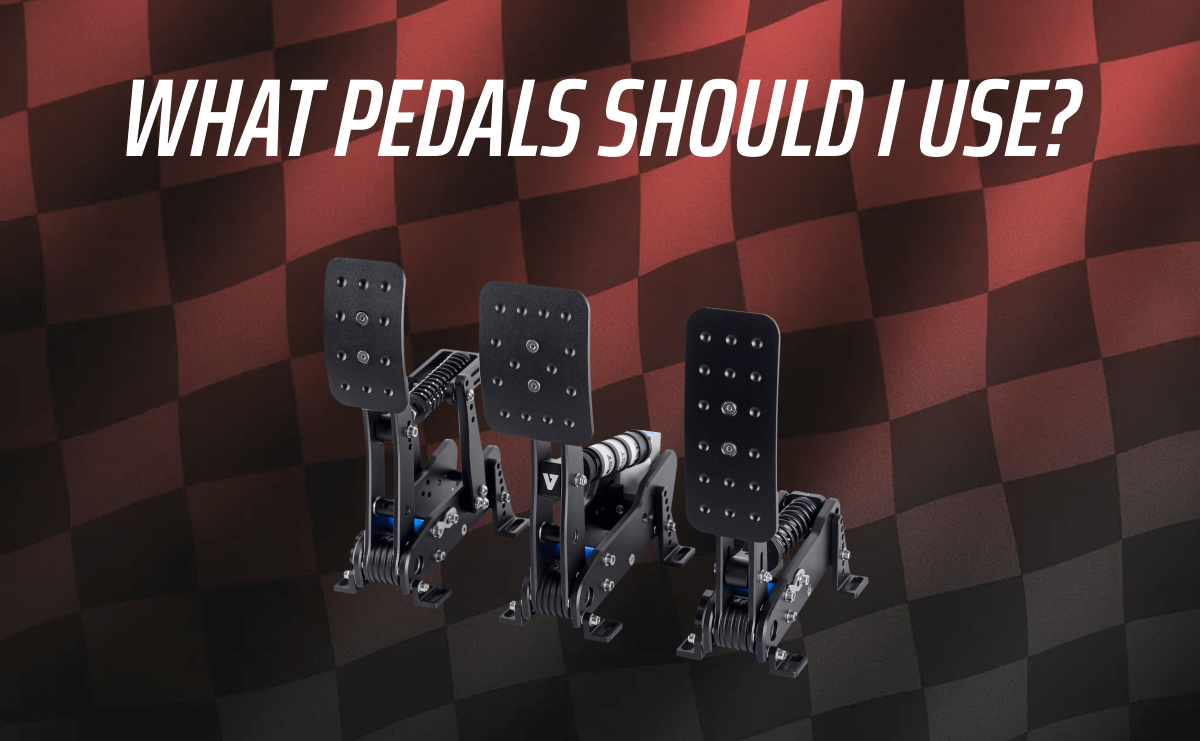A good wheelbase can deliver excellent driving feedback, allowing you to sense exactly when you're at the edge of grip or when you've exceeded it. However, there's arguably an even more critical component in your sim racing setup, one that's sometimes difficult to evaluate clearly due to the many options available.
Pedals.
Going fast is certainly important in racing, but in most scenarios, you're not simply competing in straight-line acceleration. Effective braking is equally, if not more, crucial. With countless products on the market, deciding which pedals will suit you best can be overwhelming. Should you choose angle sensor pedals? Is a load cell the ideal match for your driving style? Or perhaps hydraulic pedals for the ultimate realism?
Even within each pedal type, there is significant variation. To make your decision easier, we'll explore each pedal type, highlight key brands within each category, and clearly define their differences, saving you time and effort.
Angle Sensor Pedals:

Pedals equipped with an angle sensor use a potentiometer, a rotational sensor, to measure pedal travel. Many entry-level pedal sets from brands like MOZA and Fanatec employ this type to keep costs accessible. These pedals typically require a lighter touch and provide quicker travel, making them suitable for beginners.
Pros:
- Inexpensive and widely available.
- Easy to repair or replace.
Cons:
- Less precise braking, challenging to build consistent muscle memory.
- Prone to wear over time due to friction-based operation.
Ideal For:
- Beginners or casual sim racers who aren't heavily concerned about their finishing position.
Hall Effect Pedals:
Hall Effect pedals use magnetic sensors to measure pedal travel. These sensors detect the position based on how close a magnet is to the sensor. While still position-based like angle sensor pedals, they offer smoother and more accurate readings.
Pros:
- More durable than potentiometers.
- Consistent response and smooth pedal feel over time.
- Improved precision, especially beneficial for throttle and clutch pedals.
Cons:
- Still position-based (not force-based), so braking feel is not ideal for high-level competition.
Ideal For:
- Intermediate sim racers looking for a smoother and more precise driving experience compared to angle sensor pedals.
Load Cell Pedals
Load cell pedals mark a significant improvement in realism compared to previous pedal types. Instead of measuring pedal travel, load cell pedals measure pressure based on the force applied. Prominent examples include Heusinkveld Sprints and VNM pedals. While throttle and clutch pedals may not always contain load cells, premium brake pedals typically feature load cell sensors capable of handling 100–200kg of pressure.
Pros:
- Realistic braking feel that encourages muscle memory and repetition.
- Essential for consistent lap times and competitive racing.
Cons:
- More expensive compared to Hall Effect or angle sensor pedals.
- Requires precise calibration and quality software/hardware for optimal performance.
Ideal For:
- Serious sim racers and esports competitors seeking realism and consistency in their driving.
Hydraulic Pedals:

If maximum immersion is your goal, hydraulic pedals should be part of your rig. Hydraulic pedals utilize both a load cell sensor and hydraulic fluid to provide realistic pedal feedback, particularly in braking. They closely emulate the feel of an actual race car's braking system. However, this realism comes with additional maintenance requirements, such as fluid replacement and pressure calibration.
A useful way to differentiate hydraulic pedals from standard load cell pedals is that hydraulic pedals simulate the actual feel of car brakes, whereas load cells only measure force without emulating pedal feel.
Pros:
- Closest possible experience to actual race car pedal feel.
- Excellent for progressive braking, trail braking, and sensitive pedal control.
Cons:
- Expensive and complex to set up.
- Requires regular maintenance (fluid replacement and pressure calibration).
- If you want inverted pedals, check if the pedals need to be adjusted so that the fluids don’t leak or cause damage to the system.
Ideal For:
- Professional sim racers, racing teams, or dedicated enthusiasts building advanced, realistic setups.
Active Pedals:

Active pedals represent a major technological leap forward in the sim racing community. Precise feedback is crucial to understanding your driving style and adapting to track conditions. While haptic add-ons exist, their feedback can be limited due to their external nature. Active pedals such as the Simucube ActivePedal Pro or the Moza mBooster resolve this issue by integrating high-precision sensors and force feedback actuators directly into the pedal base.
Due to their complexity, active pedals offer advanced software customization, allowing you to finely adjust the pedal response to your exact driving style.
Pros:
- Highly customizable pedal feel and resistance adjustable per car and driving profile.
- Integrated force feedback to simulate conditions like ABS pulses and brake lock-up.
- Minimal mechanical wear with no springs or elastomers to degrade.
- Extremely precise and consistent pedal inputs.
Cons:
- High initial investment cost.
- Complex setup involving software and telemetry integration.
- Heavy and large, potentially unsuitable for compact rigs.
Ideal For:
- Professional esports drivers and sim racers seeking maximum realism and detailed feedback. Suitable for high-end rigs where budget and setup complexity aren't restrictive factors.


Leave a comment
All comments are moderated before being published.
This site is protected by hCaptcha and the hCaptcha Privacy Policy and Terms of Service apply.